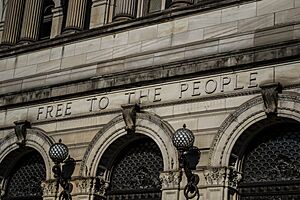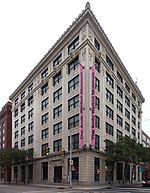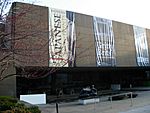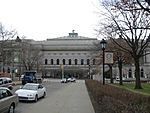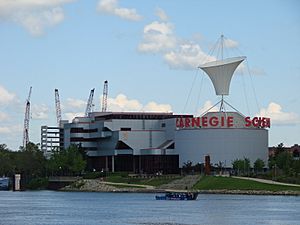Carnegie Museums of Pittsburgh facts for kids
|
Carnegie Institute and Library
|
|
|
U.S. Historic district
Contributing property |
|

The Carnegie Institute serves as the headquarters of the Carnegie Museums
|
|
| Location | 4400 Forbes Ave., Pittsburgh, Pennsylvania |
|---|---|
| Area | 9.5 acres (3.8 ha) |
| Built | 1895 |
| Architectural style | Beaux Arts |
| Part of | Schenley Farms Historic District (ID83002213) |
| NRHP reference No. | 79002158 |
Quick facts for kids Significant dates |
|
| Added to NRHP | March 30, 1979 |
| Designated CP | July 22, 1983 |
The Carnegie Museums of Pittsburgh is a group of four amazing museums in Pittsburgh, Pennsylvania, USA. They are all run by a special organization that helps people learn and explore. The main office for these museums is in a big building called the Carnegie Institute and Library. This building is in the Oakland neighborhood of Pittsburgh. It's so important that it was added to the National Register of Historic Places on March 30, 1979.
Contents
Exploring the Carnegie Museums
Two of the Carnegie Museums, the Carnegie Museum of Natural History and the Carnegie Museum of Art, are located in the main Carnegie Institute and Library building. This building is a famous landmark. It also holds the Carnegie Music Hall and the main branch of the Carnegie Library of Pittsburgh.
A very generous person named Andrew Carnegie gave the money for these libraries and buildings. He wanted to inspire people to do good things for themselves and their communities. He asked communities to help support the places he built. The words "free to the people" are carved above the library entrance. This shows his big idea. The other two museums, The Andy Warhol Museum and the Kamin Science Center, are in different places. They are located on Pittsburgh's North Shore.
The Andy Warhol Museum
The Andy Warhol Museum opened on May 15, 1994. It was the first museum ever to focus only on an American artist who became famous after World War II. The building where the museum is located was first built in 1911 for factories. Later, an architect named Richard Gluckman changed it into a museum. Today, the museum has seven floors of art displays. It also has an underground learning studio and a special lab to take care of the art.
Andy Warhol was known for his "pop art" style, especially using a method called silkscreen. He became very famous in the early 1960s. His art often showed everyday things and famous people. He used images like Marilyn Monroe and Campbell's soup cans. These artworks helped him become a pop art legend.
The museum has over 4,000 of Warhol's artworks. These include paintings, drawings, prints, photos, and sculptures. It also has all of his video collection, including 228 short films called "Screen Tests." The museum also keeps many of Warhol's personal archives, like his "Time Capsules." While the museum is mostly about Andy Warhol, it also shows art from many other modern artists.
The Carnegie Museum of Art
When Andrew Carnegie imagined a museum, he wanted it to collect art from the "Old Masters of tomorrow." This means he wanted to collect art that would be famous in the future. The Carnegie Museum of Art was one of the first museums in the United States to focus on modern art. It started in 1895 as the Department of Fine Arts. Its name was changed to the Carnegie Museum of Art in 1986.
Today, the museum still shows contemporary art (art made recently). It hosts a big show called the Carnegie International every few years. Many artworks from these shows have been bought for the museum's permanent collection. These include famous pieces like Winslow Homer's The Wreck (1896). Another is James A. McNeill Whistler's Arrangement in Black: Portrait of Señor Pablo de Sarasate (1884).
The Hall of Sculpture is made of white marble. It looks like the inside of the ancient Greek building, the Parthenon. The Hall of Architecture has the largest collection of plaster casts of famous buildings in America. It is one of the three biggest collections in the world. The Sarah Scaife Galleries Annex opened in 1974. It was designed by Edward Larrabee Barnes and Associates. A gift from the Sarah Scaife Foundation almost doubled the museum's display space. The new part was designed to fit in without taking away from the older building.
The Heinz Architectural Center opened in 1993 as part of the museum. It collects and shows architectural drawings, prints, and models. Most of these are from the 1800s and 1900s.
In 2001, the museum received a huge collection from an African-American photographer named Charles "Teenie" Harris. This collection has about 80,000 photos from the 1930s to the 1970s. Many of these pictures have been organized and put online.
The museum's permanent collection includes art from Europe and America. It has decorative arts from the late 1600s to today. It also has works on paper, paintings, prints (especially Japanese prints), sculptures, and art installations.
The Carnegie Museum of Natural History
The Carnegie Museum of Natural History opened in 1895, at the same time as the Carnegie Museum of Art. Today, it holds over twenty million objects and artifacts. Andrew Carnegie himself helped collect items for the museum from 1895 to 1907. His ideas about how life developed influenced what was collected.
One of its most famous collections is 230 dinosaur fossils. This includes the most complete Tyrannosaurus rex skeleton ever found. The museum also has cool exhibits like the Hillman Hall of Minerals and Gems. There is also the Alcoa Foundation Hall of American Indians. And don't forget the Walton Hall of Ancient Egypt. The museum also has a special place called the Powdermill Nature Reserve. It was started in 1956. This reserve is used by scientists to study animals and plants in nature over a long time. Research teams from the Carnegie Museum have made important discoveries. These include new ancient animals like Puijila darwini and Hadrocodium wui.
The Kamin Science Center
The Kamin Science Center opened in 1991. However, its history goes back to October 24, 1939. It is the most visited museum in Pittsburgh. The Kamin Science Center has the Buhl Planetarium & Observatory. It also has the Rangos Giant Cinema Theater. There are many exhibits that change, and some that are always there. These include Highmark SportsWorks, the Miniature Railroad & Village, and the Robot Hall of Fame.
On February 21, 1990, a Pennsylvania Senator named John Heinz helped make it possible for the USS Requin to come to the science center. The USS Requin is a World War II submarine. Visitors can go inside to learn how people lived and worked on the boat.
The Buhl Planetarium and the larger Carnegie Museums of Pittsburgh joined together in 1987. This led to the start of building the new Carnegie Science Center in October 1989. A big donation from the Kamin family caused the science center to be renamed in 2024.
See also
 In Spanish: Museos Carnegie de Pittsburgh para niños
In Spanish: Museos Carnegie de Pittsburgh para niños


